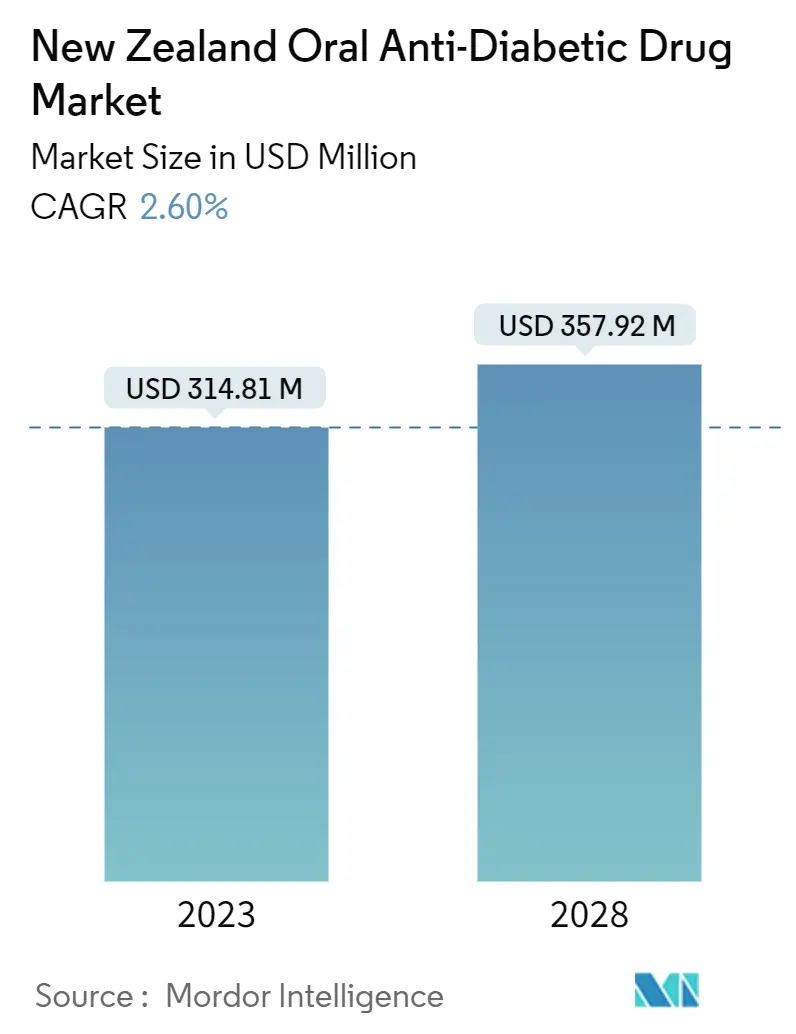Market Size of New Zealand Oral Anti-Diabetic Drug Industry

| Study Period | 2019 - 2029 |
| Base Year For Estimation | 2023 |
| Market Size (2024) | USD 323 Million |
| Market Size (2029) | USD 367.23 Million |
| CAGR (2024 - 2029) | 2.60 % |
| Market Concentration | Medium |
Major Players
*Disclaimer: Major Players sorted in no particular order |
New Zealand Oral Anti-Diabetic Drug Market Analysis
The New Zealand Oral Anti-Diabetic Drug Market size is estimated at USD 314.81 million in 2023, and is expected to reach USD 357.92 million by 2028, growing at a CAGR of 2.60% during the forecast period (2023-2028).
The market for oral anti-diabetic drugs in New Zealand is expected to record significant growth, propelled by the rising prevalence of diabetes and a preference for oral treatments. With diabetes posing numerous health risks, patients must monitor their blood glucose levels consistently.
The surging prevalence of diabetes in the region is indicative of the rising need for oral anti-diabetic medications. As per the International Diabetes Federation (IDF), in 2022, New Zealand reported approximately 18,000 cases of type-1 diabetes, with 2.2 thousand patients under the age of 20, 11.5 thousand aged between 20-59, and 4.4 thousand over 60. These figures underscore the urgent demand for oral anti-diabetic drugs, signaling significant market expansion.
Initiatives by non-profit organizations to bolster diabetes screening have significantly increased. For instance, in April 2024, the Diabetes NZ Auckland team intensified efforts to link mobile testing, HOPE education for diabetes prevention, and diabetes self-management programs in Auckland. With enhanced diabetes screening, the number of diagnosed individuals is likely to rise, subsequently boosting the demand for oral anti-diabetic medications.
Given the high prevalence of diabetes and the increasing shift toward oral treatments, the market for oral anti-diabetic drugs is on track for substantial growth in New Zealand. As healthcare practices advance, the demand for effective diabetes management solutions is expected to maintain this growth trajectory.
New Zealand Oral Anti-Diabetic Drug Industry Segmentation
Orally administered anti-diabetic drugs reduce blood glucose levels. They are often used in type 2 diabetes care.
The oral anti-diabetic drug market in New Zealand is segmented by drugs into biguanides, alpha-glucosidase inhibitors, sulphonylurea, sodium-glucose cotransport-2 (SGLT-2) inhibitors, dipeptidyl peptidase-4 (DPP-4) inhibitors, and others. The report offers the value (USD) for all the above segments.
| By Drug Type | |
| Biguanides | |
| Alpha-Glucosidase Inhibitors | |
| Sodium-Glucose Cotransport-2 (SGLT-2) Inhibitors | |
| Dipeptidyl Peptidase-4 (DPP-4) Inhibitors | |
| Sulfonylureas | |
| Others |
New Zealand Oral Anti-Diabetic Drug Market Size Summary
The New Zealand oral anti-diabetic drug market is experiencing a steady growth trajectory, driven by the increasing prevalence of diabetes and the need for effective management solutions. The market is characterized by a consolidated landscape, with major global players such as Eli Lilly, AstraZeneca, Sanofi, and Janssen Pharmaceuticals leading the charge. These companies are focusing on innovative drug developments to cater to the rising demand for diabetes management. The market dynamics are influenced by the growing incidence of type 1 and type 2 diabetes, exacerbated by lifestyle factors and the COVID-19 pandemic, which has highlighted the importance of accessible diabetes care and treatment options.
The market's expansion is further supported by advancements in drug therapies, including Sodium-glucose Cotransport-2 (SGLT-2) inhibitors and GLP-1-based medications, which play a crucial role in glucose regulation and insulin secretion. Despite the availability of these treatments, access and affordability remain challenges for a significant portion of the population in New Zealand. The healthcare system, comprising primary and secondary care services, strives to address these issues, although disparities exist, particularly among Pacific, Māori, and South Asian communities. Initiatives like Pharmac's funding approvals and awareness campaigns aim to improve access to essential medications for those in need, underscoring the ongoing efforts to enhance diabetes care across the country.
New Zealand Oral Anti-Diabetic Drug Market Size - Table of Contents
-
1. MARKET DYNAMICS
-
1.1 Market Overview
-
1.2 Market Drivers
-
1.2.1 Rising Prevalence of Diabetes
-
1.2.2 Reimbursement Policies for Diabetes Oral Medications
-
-
1.3 Market Restraints
-
1.3.1 Stringent Regulatory Requirements for Product Approval
-
-
1.4 Porter's Five Forces Analysis
-
1.4.1 Bargaining Power of Suppliers
-
1.4.2 Bargaining Power of Consumers
-
1.4.3 Threat of New Entrants
-
1.4.4 Threat of Substitute Products and Services
-
1.4.5 Intensity of Competitive Rivalry
-
-
-
2. MARKET SEGMENTATION (Market Size -Value USD)
-
2.1 By Drug Type
-
2.1.1 Biguanides
-
2.1.2 Alpha-Glucosidase Inhibitors
-
2.1.3 Sodium-Glucose Cotransport-2 (SGLT-2) Inhibitors
-
2.1.4 Dipeptidyl Peptidase-4 (DPP-4) Inhibitors
-
2.1.5 Sulfonylureas
-
2.1.6 Others
-
-
New Zealand Oral Anti-Diabetic Drug Market Size FAQs
How big is the New Zealand Oral Anti-Diabetic Drug Market?
The New Zealand Oral Anti-Diabetic Drug Market size is expected to reach USD 323 million in 2024 and grow at a CAGR of 2.60% to reach USD 367.23 million by 2029.
What is the current New Zealand Oral Anti-Diabetic Drug Market size?
In 2024, the New Zealand Oral Anti-Diabetic Drug Market size is expected to reach USD 323 million.

